访问HelloWorld应用的路径的设置
HelloWorldAction文件:
package cn.itcast.primer;
import com.opensymphony.xwork2.ActionSupport;
public class HelloWorldAction extends ActionSupport{
public String execute() throws Exception {
System.out.println("HelloWorldAction ************* execute()");
return "success";
}
}
struts.xml
<package name="primer" namespace="/primer" extends="struts-default">
<action name="helloWorldAction" class="cn.itcast.primer.HelloWorldAction">
<result name="success" type="dispatcher">/primer/success.jsp</result>
</action>
</package>
在struts2中,访问struts2中action的URL路径由两部份组成:
包的命名空间+action的名称
例如: 访问本例子HelloWorldAction的URL路径为: /primer/helloWorldAction.action (注意:完整路径为:http://localhost:端口/内容路径/primer/helloWorldAction.action)。另外我们也可以加上.action后缀访问此Action。
<package name="primer" namespace=“/primer“ extends="struts-default">
<action name="helloWorldAction" class="cn.itcast.primer.HelloWorldAction">
<result name="success" type="dispatcher">/success.jsp</result>
</action>
</package>
指定多个struts配置文件
在大部分应用里,随着应用规模的增加,系统中Action的数量也会大量增加,导致struts.xml配置文件变得非常臃肿。为了避免struts.xml文件过于庞大、臃肿,提高struts.xml文件的可读性,我们可以将一个struts.xml配置文件分解成多个配置文件,然后在struts.xml文件中包含其他配置文件。下面的struts.xml通过元素指定多个配置文件:
<struts>
<include file="struts-user.xml"/>
<include file="struts-order.xml"/>
</struts>
通过这种方式,我们就可以将Struts 2的Action按模块添加在多个配置文件中。
struts.xml文件配置:
<?xml version="1.0" encoding="UTF-8"?>
<!DOCTYPE struts PUBLIC
"-//Apache Software Foundation//DTD Struts Configuration 2.3//EN"
"http://struts.apache.org/dtds/struts-2.3.dtd">
<struts>
<!-- 引入自定义配置文件 -->
<include file="cn/itcast/primer/struts_primer.xml"></include>
</struts>
自定义配置文件struts_primer.xml:
<?xml version="1.0" encoding="UTF-8"?>
<!DOCTYPE struts PUBLIC
"-//Apache Software Foundation//DTD Struts Configuration 2.3//EN"
"http://struts.apache.org/dtds/struts-2.3.dtd">
<struts>
<!-- /primer/helloWorldAction.action
package:包
* name:包名,唯一的,必选项
* namespace:命名空间,唯一的,相当于房间号。可选项,省略情况下是"/"。页面中请求连接的前半部分
* extends:继承
* extends="struts-default":struts2框架底层提供的核心包struts2-core-2.3.3.jar下的struts-default.xml文件
* 为什么要继承这个struts-default.xml文件?
* 因为struts2框架底层提供的struts-default.xml声明了所有的拦截器和拦截器栈,
知道在struts2框架运行时执行struts-default.xml文件中的拦截器栈。
* 如果不继承struts-default.xml文件,就没有办法使用struts2框架提供的所有拦截器
-->
<package name="primer" namespace="/primer" extends="struts-default">
<!--
如果找不到对应的action名的时候,配置默认要执行的action
* name:指定action的名称
-->
<default-action-ref name="helloWorldAction"></default-action-ref>
<!--
action:
* name:对应页面中请求连接的后面半部分
* class:对应要执行的类的完整路径
-->
<action name="helloWorldAction" class="cn.itcast.primer.HelloWorldAction">
<!--
result:结果类型
* name:对应的是执行的类的方法的返回值
public String execute() throws Exception {
System.out.println("HelloWorldAction ************* execute()");
return "success";
}
* 后半部分的文本内容:要转向到的页面
-->
<result name="success">/primer/success.jsp</result>
</action>
<!--
没有为action指定class
* 在struts2框架底层的struts-default.xml文件中,配置了默认执行的类
com.opensymphony.xwork2.ActionSupport
public String execute() throws Exception {
return SUCCESS;
}
* 实际上,默认执行的是底层提供的ActionSupport类的execute()方法
* result结果类型,默认是根据struts2框架底层提供的ActionSupport类的execute()方法返回值,进行跳转
-->
<action name="actionNoClass">
<result name="success">/primer/success.jsp</result>
</action>
</package>
</struts>自定义配置文件需要放置在对应的包内,如图所示:
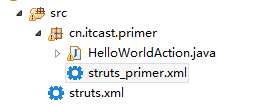
struts.xml文件配置中还需要引入自定义配置文件
Action名称的搜索顺序
test.jsp文件:
<%@ page language="java" pageEncoding="utf-8" contentType="text/html; charset=utf-8"%>
<%@ taglib uri="/struts-tags" prefix="s"%>
<html>
<head>
<title>My JSP 'index.jsp' starting page</title>
</head>
<body>
入门的路径:<br>
<a href="${pageContext.request.contextPath}/primer/helloWorldAction.action">helloWorld</a><br>
测试Action名称的搜索顺序:<br>
<a href="${pageContext.request.contextPath}/primer/primer/aaa/primer/helloWorldAction.action">helloWorld</a><br>
<a href="${pageContext.request.contextPath}/primer/primer/helloWorldAction.action">helloWorld</a><br>
<a href="${pageContext.request.contextPath}/primer/helloWorldAction.action">helloWorld</a><br>
没有为action指定class<br>
<a href="${pageContext.request.contextPath}/primer/actionNoClass.action">helloWorld</a><br>
测试struts2 输出没有命名空间helloworld:<br>
<a href="${pageContext.request.contextPath}/primer/userAction.action">helloWorld</a><br>
</body>
</html>
- 测试第一个超链接
- 测试第二个超链接
- 测试第三个超链接
- 测试第四个超链接
- 测试第五个超链接
- 测试第六个超链接
总结:
1.获得请求路径的URI,例如url是:
http://server/struts2/path1/path2/path3/test.action
2.首先寻找namespace为/path1/path2/path3的package,
如果存在这个package,则在这个package中寻找名字为test的action,
如果不存在这个package则转步骤3;
3.寻找namespace为/path1/path2的package,
如果存在这个package,则在这个package中寻找名字为test的action,
如果不存在这个package,则转步骤4;
4.寻找namespace为/path1的package,
如果存在这个package,则在这个package中寻找名字为test的action,
如果仍然不存在这个package,就去默认的namaspace的package下面去找名
字为test的action(默认的命名空间为空字符串“/” ),
如果还是找不到,页面提示找不到action。
Action配置中的各项默认值
问题如果没有为action指定class,默认是com.opensymphony.xwork2.ActionSupport执行ActionSupport中的execute方法 ,由struts-default.xml文件<default-class-ref class="com.opensymphony.xwork2.ActionSupport" />决定
<package name="primer" namespace="/primer" extends="struts-default">
<!--
没有为action指定class
* 在struts2框架底层的struts-default.xml文件中,配置了默认执行的类
com.opensymphony.xwork2.ActionSupport
public String execute() throws Exception {
return SUCCESS;
}
* 实际上,默认执行的是底层提供的ActionSupport类的execute()方法
* result结果类型,默认是根据struts2框架底层提供的ActionSupport类的execute()方法返回值,进行跳转
-->
<action name="actionNoClass">
<result name="success">/primer/success.jsp</result>
</action>
</package>- 如果没有为action指定class,默认是ActionSupport。
- 如果没有为action指定method,默认执行action中的execute() 方法。ActionSupport的execute方法里面就一句话return “success”;
- 如果没有指定result的name属性,默认值为success。
问题:如果请求的路径查找不到action的情况下,程序运行会抛出异常 ,可以通过配置当找不到action的情况下,会执行默认的action
<package name="primer" namespace="/primer" extends="struts-default">
<!--
如果找不到对应的action名的时候,配置默认要执行的action
* name:指定action的名称
-->
<default-action-ref name="helloWorldAction"></default-action-ref>
</package>ActionSupport
ActionSupport类是默认的 Action 类. 在编写 Action 类时, 通常会对这个类进行扩展
Struts 2处理的请求后缀
StrutsPrepareAndExecuteFilter是Struts 2框架的核心控制器,它负责拦截由<url-pattern>/*</url-pattern>指定的所有用户请求,当用户请求到达时,该Filter会过滤用户的请求。默认情况下,如果用户请求的路径不带后缀或者后缀以.action结尾,这时请求将被转入Struts 2框架处理,否则Struts 2框架将略过该请求的处理。
根据配置文件:struts2-core-2.3.31.jar包下的 org.apache.struts2/default.properties文件定义的常量决定
struts.action.extension=action,,
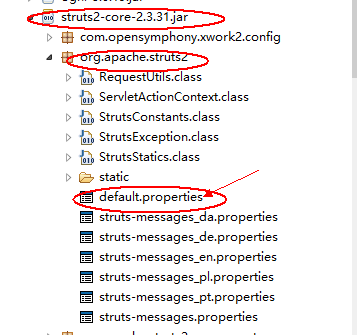
默认处理的后缀是可以通过常量”struts.action.extension“进行修改的,如下面配置Struts 2只处理以.do为后缀的请求路径:
<struts>
<constant name="struts.action.extension" value="do"/>
</struts>
struts.xml文件:
<?xml version="1.0" encoding="UTF-8"?>
<!DOCTYPE struts PUBLIC
"-//Apache Software Foundation//DTD Struts Configuration 2.3//EN"
"http://struts.apache.org/dtds/struts-2.3.dtd">
<struts>
<!--
constant:配置常量
* name:指定的是struts2框架底层提供的default.properties资源文件中配置的"常量"
* value:指定的是配置常量的值
* 在struts.xml文件中,配置的常量的值会覆盖底层提供的default.properties资源文件中配置的常量的值
* 配置struts2框架的页面中请求连接的后缀名,如果指定多个的话,用","隔开
* 如果在struts.xml中和struts.properties资源文件中同时进行配置,struts.properties的配置起作用
* 因为常量可以在多个配置文件中进行定义,所以我们需要了解下struts2加载常量的搜索顺序:
1 struts-default.xml
2 struts-plugin.xml
3 struts.xml
4 struts.properties(自己创建)
5 web.xml
-->
<!-- <constant name="struts.action.extension" value="do,love"></constant> -->
<!-- 引入自定义配置文件 -->
<include file="cn/itcast/primer/struts_primer.xml"></include>
</struts>细说常量定义
常量可以在struts.xml或struts.properties中配置,建议在struts.xml中配置,两种配置方式如下:
1.在struts.xml文件中配置常量
<struts>
<constant name="struts.action.extension" value="do"/>
</struts>
2.在struts.properties中配置常量, (struts.properties文件放置在src下)
struts.action.extension=do
因为常量可以在多个配置文件中进行定义,所以我们需要了解下struts2加载常量的搜索顺序:
1 struts-default.xml
2 struts-plugin.xml
3 struts.xml
4 struts.properties
5 web.xml
如果在多个文件中配置了同一个常量,则后一个文件中配置的常量值会覆盖前面文件中配置的常量值.
常用的常量介绍
指定默认编码集,作用于HttpServletRequest的setCharacterEncoding方法 和freemarker 、velocity的输出
<constant name="struts.i18n.encoding" value="UTF-8"/>该属性指定需要Struts 2处理的请求后缀,该属性的默认值是action,即所有匹配*.action的请求都由Struts2处理。
如果用户需要指定多个请求后缀,则多个后缀之间以英文逗号(,)隔开<constant name="struts.action.extension" value="do"/>- 设置浏览器是否缓存静态内容,默认值为true(生产环境下使用),开发阶段最好关闭
<constant name="struts.serve.static.browserCache" value="false"/> 当struts的配置文件修改后,系统是否自动重新加载该文件,默认值为false(生产环境下使用),开发阶段最好
<constant name="struts.configuration.xml.reload" value="true"/>开发模式下使用,这样可以打印出更详细的错误
<constant name="struts.devMode" value="true" />默认的视图
<constant name="struts.ui.theme" value="simple" />与spring集成时,指定由spring负责action对象的
<constant name="struts.objectFactory" value="spring" />该属性设置Struts 2是否支持动态方法调用,该属性的默认值是true。如果需要关闭动态方法调用,则可设置该属性为 false
<constant name="struts.enable.DynamicMethodInvocation" value="false"/>上传文件的大小限制
<constant name="struts.multipart.maxSize" value=“10701096"/>struts.xml文件配置:
<?xml version="1.0" encoding="UTF-8"?>
<!DOCTYPE struts PUBLIC
"-//Apache Software Foundation//DTD Struts Configuration 2.3//EN"
"http://struts.apache.org/dtds/struts-2.3.dtd">
<struts>
<!--
constant:配置常量
* name:指定的是struts2框架底层提供的default.properties资源文件中配置的"常量"
* value:指定的是配置常量的值
* 在struts.xml文件中,配置的常量的值会覆盖底层提供的default.properties资源文件中配置的常量的值
* 配置struts2框架的页面中请求连接的后缀名,如果指定多个的话,用","隔开
* 如果在struts.xml中和struts.properties资源文件中同时进行配置,struts.properties的配置起作用
* 因为常量可以在多个配置文件中进行定义,所以我们需要了解下struts2加载常量的搜索顺序:
1 struts-default.xml
2 struts-plugin.xml
3 struts.xml
4 struts.properties(自己创建)
5 web.xml
-->
<!-- <constant name="struts.action.extension" value="do,love"></constant> -->
<!-- 配置国际化资源文件修改时,是否重新加载。默认是false为不加载,true是加载 -->
<!-- <constant name="struts.i18n.reload" value="true"></constant> -->
<!-- 配置struts2框架的配置文件修改时,是否重新加载。默认是false为不加载,true是加载 -->
<!-- <constant name="struts.configuration.xml.reload" value="true"></constant> -->
<!--
配置struts2框架的模式
* 默认值是false,是生产模式
* true是开发模式,需要更多的调试信息
### includes:
### - struts.i18n.reload = true
### - struts.configuration.xml.reload = true
-->
<constant name="struts.devMode" value="true"></constant>
<!-- 配置动态方法调用,设置成不开启。默认是true是开启状态;false是不开启状态 -->
<constant name="struts.enable.DynamicMethodInvocation" value="false"></constant>
<!--
配置所有资源文件,省略后缀名,如果配置多个资源文件时,用","隔开。不仅是国际化资源文件
* 类型转换器的错误提示资源文件
-->
<constant name="struts.custom.i18n.resources"
value="cn.itcast.converter.converter,
cn.itcast.i18n.resources">
</constant>
<!-- 配置文件上传的总大小 -->
<constant name="struts.multipart.maxSize" value="2097152000"></constant>
<!-- 引入自定义配置文件 -->
<include file="cn/itcast/primer/struts_primer.xml"></include>
</struts>











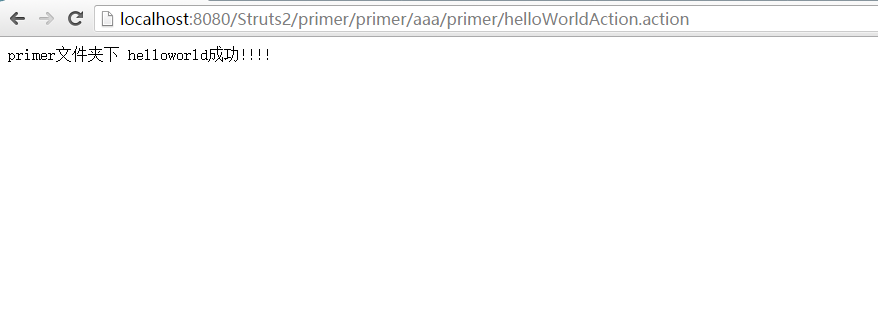
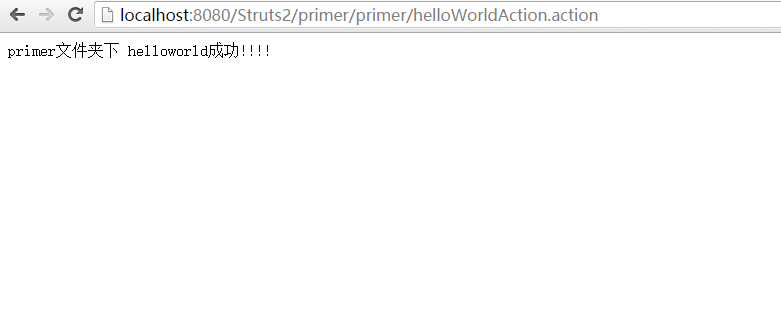
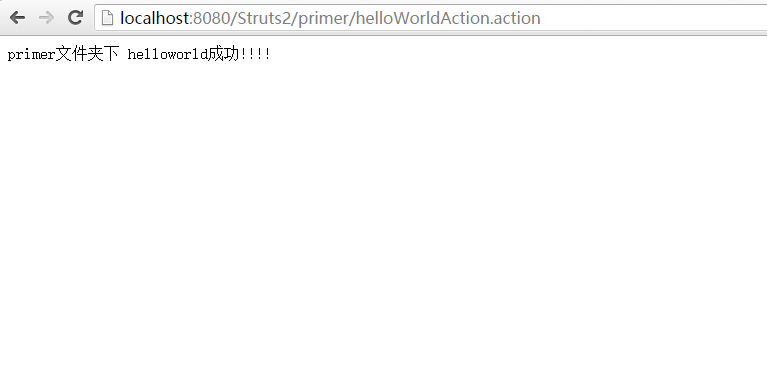
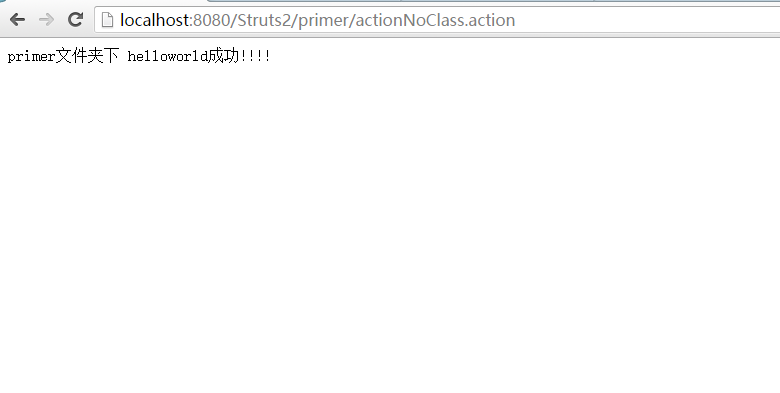
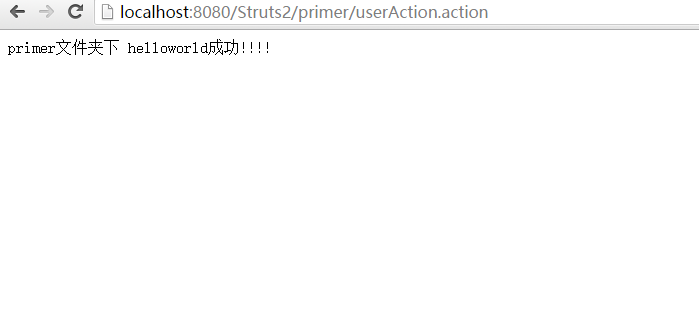
















 171
171

 被折叠的 条评论
为什么被折叠?
被折叠的 条评论
为什么被折叠?








